This is the second part of a three-part series diving deep into the heart of the debate dividing Democrats in their efforts to fix the U.S. health care system. It was reported by the team at Tradeoffs, a new podcast exploring America’s confusing, costly and often counterintuitive health care system.
Last night’s Democratic debate saw Senators Sanders and Warren pushing once again for “Medicare for all,” and Vice-President Biden and Mayor Buttigieg continuing to back a so-called public option.
Up until now, it’s been tough to compare the two plans.
But today the Urban Institute, a center-left think tank, is out with a major report stacking them up side-by-side. Who will they cover? What will they cost?
To answer those questions, the Urban Institute ran these two popular proposals through an economic modeling machine to predict their impact. The versions they analyzed resemble those proposed by some of the leading Democratic contenders.
Definitions
“Medicare for all”—sometimes called single-payer—replaces our current system with a plan run and paid for by the federal government.
The “public option” effectively preserves our current system, adding a publicly run plan to compete with private insurance. The version Urban analyzed is bulked up with more than half a dozen other provisions aimed at maximizing access and affordability.
Time to Talk Tradeoffs
There are dozens of tradeoffs you could explore in this 70-page report. We are going to focus on two that will make the differences between these plans quite stark.
Coverage: Who Gets What?
Medicare for all would live up to its name, covering every single person living in this country—all with the exact same plan. That plan would also cover dental, vision, hearing, and long-term care services—a much more generous set of benefits compared to what is covered by private insurance and Medicare today.
Under the public option, every American would be insured. However, seven million undocumented immigrants would remain uninsured. As for benefits, both public and private insurers would offer roughly what is available today under the Affordable Care Act.
Cost: Who Pays What?
To wrap your head around the price tags these plans carry, it helps to start by imagining a pie chart. Each wedge of that pie represents part of America’s total economy. One wedge is what the entire country spends on health care—individuals, families, states, the federal government, employers—all of us.
Even if the U.S. sticks with its current health care system, that wedge is going to keep growing, totaling $52 trillion over the next decade.
The Urban Institute’s report finds that “Medicare for all” would accelerate the growth of that health care wedge by an extra $7 trillion. The “public option” would actually shrink that $52 trillion wedge by a tiny bit.
Here’s why some people care about the size of this gigantic slice of policy pie: The bigger it gets, the less there is left to spend on things like education and public safety.
But, the size of the slice is not the only thing that matters. It is also important to ask: Who is paying for all of that pie?
Under Medicare for all, the federal government picks up basically the whole bill. As a result, according to the Urban Institute, the federal government’s spending on health care would increase by $34 trillion over the next decade. Federal spending would go up under the public option, too—but by a lot less: just $1.5 trillion over that same time period.
When the federal government’s portion of the nation’s health care bill climbs, it needs to find new funds somewhere.
Although the Urban Institute's analysis does not discuss tax implications, it’s very likely that Medicare for all would result in a tax hike for most people. At the same time, however, Medicare for all also eliminates all out-of-pocket-costs. There are no deductibles, no premiums, no-copays. Nothing. That means, overall, most people would still end up spending less on health care despite the tax bump.
The public option would also likely raise taxes, but not by nearly as much. Unlike Medicare for all, the public option approach still requires individuals and employers to shoulder some health care costs in the form of premiums, deductibles, and co-pays. The difference, however, would be in the size of those costs. Compared to what people pay today, the public option would lower out-of-pocket costs by 20 to 80%, depending largely on a person or family’s income. Those savings mean that, just like under Medicare for all, most people will likely spend less on health care than they do today.
In the wake of all these data, details, and tradeoffs, Democratic politicians and voters alike are left with one big question: Which imperfect solution do you prefer?
Your answer will depend on how you feel about things like taxes, spending, and whether health care is a right.
Tomorrow, the final part of this series will look at how Democrats are preparing to reckon with the reality check this paper provides.



